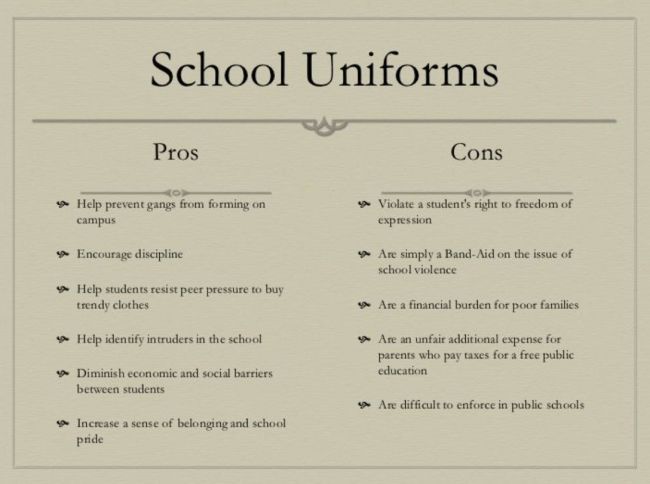President Clinton called for uniform requirements in American schools in his 1996 State of the Union address. School dress codes were implemented by many schools after this suggestion was found to be too extreme and some schools complied.
In contrast to uniform policies, which specify what students must wear, school dress codes specify what students cannot wear. Dress codes are bad for students and staff for several reasons.
Targets Female Students
There is a wide variation in dress codes between districts. Most dress codes prohibit leggings, short skirts, t-shirts with vulgar language, and bare midriffs.
“(A)t my school, there is an unfair dress code for girls while boys can wear whatever they want.” — Reader comment from “person”
Double-Standard
By banning specific items like leggings and midriff-baring tops, schools send a negative message to both genders. It is not uncommon for girls to be told that their clothing is distracting and boys cannot pay attention because of it.
Many anti-dress code advocates point out that this kind of language is sexist and sends a message to male students that they are not solely responsible for their behavior.
Disrupting Education
While the policy may state that any student who violates the dress code will be removed from class, female students typically have to leave class to go home and change, while male students may only need to make minor adjustments. School dress codes, for example, prohibit baggy pants and vulgar t-shirts.
Students can fix the violation by pulling up their pants or wearing their t-shirts inside out. There is also a ban on leggings that is equally common.
Many female students are sent home because they need to change in order to fix the violation. This is not only embarrassing, but it disrupts her education as well.

Freedom of Speech
Students’ freedom of speech is also violated by school policies that enforce strict rules for what students should wear. In a landmark case dating back to 1969, the ACLU recognized a student’s right to freedom of speech through what they wore.
Limiting Messages
Students are often restricted from sending messages by school dress codes. In Giles, Tennessee, a school told a girl she could not wear a shirt with a pro-LGBT message as it might provoke other students and make her a target.
However, restricting what students can say on their clothing actually violates their right to free speech; frequently, the American Civil Liberties Union will intervene to protect the rights of students.
“(K)ids should be able to express themselves without fear of rejection.” -A reader’s comment on Tide Pods.
Doesn’t Apply to All Codes
There are some dress code rules that don’t apply to limiting what students are allowed to wear. Courts ruled in Albuquerque that sagging jeans are not protected by freedom of speech because they do not convey a particular message but rather a fashion statement.
Freedom of Religious Expression
School dress codes often prohibit tangible symbols of religious expression. Many students have fought for the right to wear pentagrams to school, the symbol of Wicca. Nashala Hearn was suspended from school twice for wearing her hijab, which school officials claimed did not comply with dress code policies.
The federal government generally supports freedom of religion in all its forms, but that doesn’t necessarily extend to schools.
Individuals have the right to express their religious beliefs. There are, however, many symbols of religious expression that violate dress codes. School officials may find themselves in a difficult situation as a result of this.
As a result, students are forced to fight for their rights and frequently prove their religious affiliation.
Conformity
Many dress codes are intended to teach students how to dress appropriately for work. However, strict dress codes, including graduation dress codes, do not teach students to adapt their clothes for different situations at school and at work.
It is possible for students to learn how to dress like everyone else, but they may not be able to adapt this knowledge to special occasions, such as interviews, casual meetings, or how to dress appropriately outside of school and work.
While a sample dress code claims to promote and respect individuality, it also promotes conformity in order to foster school pride. In spite of limited research on conformity’s negative consequences, at the very least, conformity discourages creativity.
There’s nothing wrong with school dress codes. Kids don’t have to figure out outfits or worry about not having the latest fashions. No one gets singled out if everyone looks alike.” — Reader comment by Nic.
Difficult to Enforce
It is notoriously difficult to enforce dress codes for a variety of reasons. Besides being subjective (e.g., what one teacher considers fine, another teacher considers a violation), enforcement frequently upsets both students and parents.
Dress codes can and are enforced successfully at some schools, but more often than not, insisting on them pits school administrators, parents, and students against one another.
The right to freedom of speech and religious expression is particularly violated by such policies.
The Negatives Outweigh the Positives
It is often the case that school dress codes do more harm than good, whether they target and harm girls or violate freedoms of religious expression. In most cases, they are not followed, the administration spends a lot of time and effort enforcing them, and when law suits are brought to court, the schools often lose.
